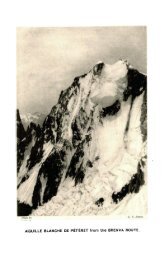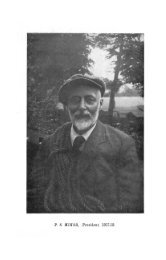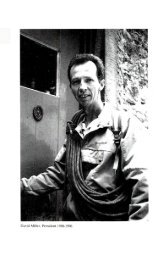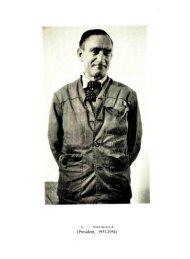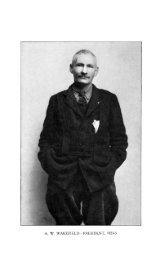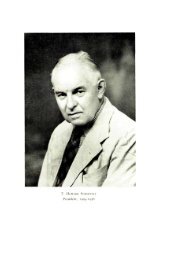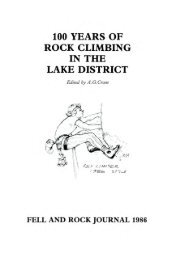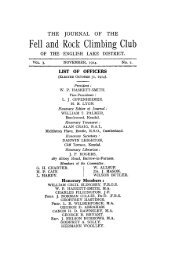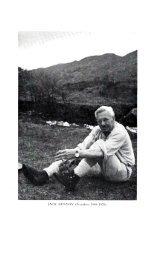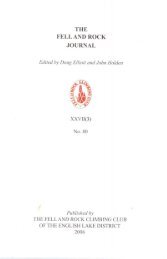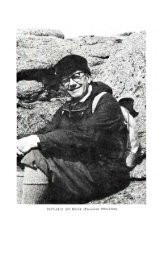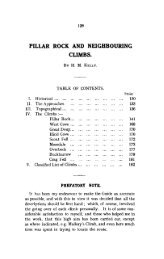Year of publication 1960 - Fell and Rock Climbing Club
Year of publication 1960 - Fell and Rock Climbing Club
Year of publication 1960 - Fell and Rock Climbing Club
Create successful ePaper yourself
Turn your PDF publications into a flip-book with our unique Google optimized e-Paper software.
Peter Grindley 27the line in a very slight groove; this combination <strong>of</strong> fingerholdswith a slight improvement in foot-grip <strong>and</strong> an occasionaltoehold is a feature <strong>of</strong> many <strong>of</strong> the best slab pitches. It makesthe difference between a slab which will go <strong>and</strong> one which willnot, <strong>and</strong> in the more pronounced form sometimes providesmeans to force otherwise intractable walls. A less reputablemethod <strong>of</strong> circumventing difficulties is by grass ledge traverses.Mourne is no more heavily vegetated than otherareas, but the small ledges, when they occur, seem to do so incompletely impossible places. Recently, while climbing withthe writer, a high <strong>of</strong>ficial <strong>of</strong> the Belfast Section <strong>of</strong> the IrishMountaineering <strong>Club</strong> followed a grass ledge down <strong>and</strong> thusupgraded the route by two degrees; but usually the ledgesare quite secure in spite <strong>of</strong> there being no supporting rockledge beneath. On most faces they are altogether absent,but a notable exception is Pigeon <strong>Rock</strong> Mountain where themain face overlooking the Spelga Pass is a system <strong>of</strong> steep rockwalls with grass <strong>and</strong> heather ledges in pr<strong>of</strong>usion between. Itreasure memories <strong>of</strong> a harassed climbing companion scalingthe upper face with the speed <strong>and</strong> dexterity <strong>of</strong> a baboon,unsympathetic friends having fired the face beneath him atthe suggestion that he was stuck.Mourne climbing is fairly recent. There was an initialphase <strong>of</strong> activity in the late thirties <strong>and</strong> about a dozen routesare recorded from this period. From the beginning <strong>of</strong> thewar until 1947 little or nothing was done; then a new schoolarose <strong>and</strong> by the early fifties was in full cry. The leadingspirits were Phil Gribbon <strong>and</strong> Maurice McMurray with othermembers <strong>of</strong> the Belfast Section <strong>of</strong> the I.M.C. <strong>and</strong> the thennewly-formed Queen's University <strong>of</strong> Belfast Mountaineering<strong>Club</strong>. The Irish Mountaineering <strong>Club</strong> cottage, the BloatHouse, was instituted <strong>and</strong> soon became the centre <strong>of</strong> a culture<strong>and</strong> civilization unknown since the days <strong>of</strong> Tara <strong>of</strong> the Kings;routes multiplied <strong>and</strong> gradings steadily advanced. The tigers<strong>of</strong> Glendalough <strong>and</strong> Dalkey Quarries occasionally raidednorth over the border leaving new climbs strewn in their wake,<strong>and</strong> from the portals <strong>of</strong> the Bloat House the fumes <strong>of</strong>Guinness <strong>and</strong> Phil Gribbon's herbal smoking mixtureascended each week-end like a grateful incense to the gods <strong>of</strong>the hills. Then in 1955 the scourge <strong>of</strong> Irel<strong>and</strong>, the tendencyto emigrate, began to deplete the Mourne climbing society.



